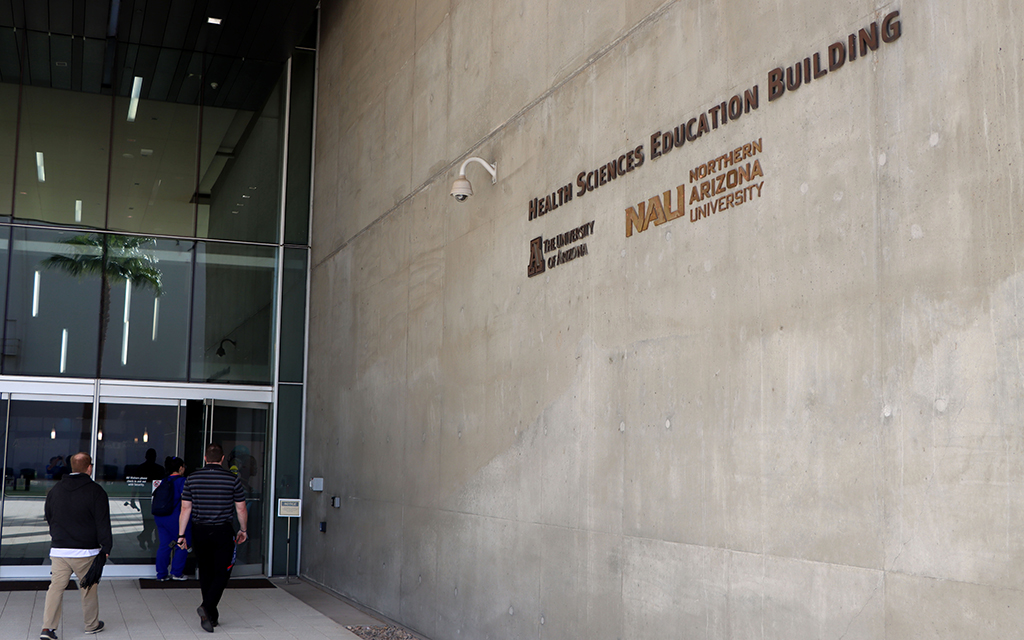
The Arizona State University Edson College of Nursing and Health Innovation is located on Fillmore and Third streets. ASU is planning to build a new medical school in downtown Phoenix. (Photo by Hunter Fore/Cronkite News)
PHOENIX – With a shortage of health care professionals across the state, Arizona’s public universities are expanding their program offerings to boost health education and the number of certified professionals.
In the past year, Arizona State University, Northern Arizona University and the University of Arizona have all announced major health care program additions.
The Arizona Board of Regents’ AZ Healthy Tomorrow initiative laid out a plan to rapidly grow the state’s health care workforce. The state’s three public universities are working to implement the plan with the creation of two new medical schools and an increase in graduates from the existing medical school.
John Arnold, executive director of the Arizona Board of Regents, said Board Chair Fred DuVal pushed the board to view medical assets in higher education as a critical issue.
ASU Health, announced in the spring, will include the School of Public Health Technology and the School of Medicine and Advanced Medical Engineering, which will be in downtown Phoenix. ASU is also expanding its collaboration with Mayo Clinic and launching a state health observatory that will help state leaders spot trends.
NAU Health is designing a new College of Medicine in Flagstaff, and it is anticipated that the first cohort will start their education in three to five years. NAU also plans to create a stand-alone College of Nursing and double the number of degrees awarded in health-related fields by 2030, Kimberly Ott, associate vice president of communications at NAU, said in an email.
UArizona Health Sciences announced the launch of a new College of Health Sciences in May. The UArizona College of Medicine also is expanding residency and fellowship positions across the state and expanding its partnership with Banner Health, according to the university.
UArizona aims to address the physician shortage in Arizona by doubling the number of its medical school graduates by 2030. Although the university is in the midst of a financial crisis, it plans to continue to work with the state Legislature on funding on the health initiative.
Because many physicians practice near where they train, increasing medical school learners can be beneficial in filling the needs of Arizona’s communities, said Dr. Jewel Kling, an internist and women’s health specialist at Mayo Clinic.
“Addressing the need for access to health care, including the clinicians that are there to care for those patients, is of utmost importance,” said Kling, who also boasts credentials as chair of the Division of Women’s Health Internal Medicine in Arizona at Mayo Clinic and dean of the Mayo Clinic Alix School of Medicine AZ campus.
More than one in three hospitals in Arizona face a critical staffing shortage, according to Becker’s Hospital Review.
According to an ABOR analysis, the state needs 14,291 registered nurses, 3,644 physicians, and 2,419 behavioral health workers, among others, by 2030 to fill its health care worker shortage.
Jay Nix, a 2022 ASU graduate and second-year Mayo Clinic Alix School of Medicine student, wants to pursue child and adolescent psychiatry. Mayo Clinic has a psychiatry residency program in Minnesota.
“That’s a big deterrent for me for staying (in Arizona to practice),” Nix said. “I would love to stay and help because I’ve done a lot of work in the community in downtown Phoenix. … I could see myself making a very big difference if the infrastructure and the resources were available.”

The Phoenix Bioscience Core is a 30-acre medical and bioscience campus in downtown Phoenix. It’s a partnership between Northern Arizona University and the University of Arizona, which are both expanding their health education programs. (Photo by Hunter Fore/Cronkite News)
Limits on Arizona’s current health care system
Access to health care is a huge problem with many people unable to see primary care providers just to check blood pressure or get breast cancer screenings, Kling said.
“That’s greatly going to impact not only them but our greater community because of the repercussions of later diagnoses,” Kling said.
The behavioral health care shortage is so severe that entities needing more behavioral health workers have stopped recruiting because they just can’t find qualified candidates, Arnold said.
Plus, Arizona has a growing and aging population that will demand more health care services in the future, contributing to co-morbidity and chronic care issues, with fewer health care providers to care for them, Barret Michalec, an associate professor in ASU’s Edson College of Nursing and Health Innovation, said in an email.
“Nationally, you have a significant shortage of health care professionals, high turn-over rates, and what could be a staggering number of retirements on the horizon in the clinical and educational sectors,” Michalec said.
As of 2019, the average age of Arizona physicians was 49.63, according to a UArizona Center for Rural Health study.
The high costs associated with applying to medical school, along with the debt-ridden nature of attending medical school, excludes many people from the medical workforce, according to a study authored by Michalec.
As the health workforce ages, the importance of educating young professionals to take their place has become even more vital.
“You want to increase the health care workforce – and the diversity of that workforce – let’s look at the structure and design of how students get to be doctors,” Michalec said. “NAU is explicitly stating that cost and affordability is a priority and that is essential.”
NAU’s Ott said the College of Medicine includes affordable options for Arizona residents who want to attend medical school – with a plan to cover the educational costs of students who stay to practice in Arizona.
UArizona also plans to expand programs that pay off medical student loans in exchange for service in the state, Arnold said.
ASU’s med school and other plans
The Mayo Clinic and ASU Alliance for Health Care will continue to expand in the ASU Health Futures Center in northeast Phoenix. The collaboration creates a pipeline of ASU graduates who transition to Mayo.
An opening date for ASU’s med school has not yet been set.
The School of Medicine and Advanced Medical Engineering will integrate clinical medicine, biomedical science and engineering, according to ASU Health’s website.
“This is exactly what the #1 School for Innovation should be doing – taking bold, daring steps forward to tackle these massive health-related and patient-care issues,” ASU’s Michalec said. “The students coming through this medical program will be thought leaders, innovators of industry, and agents of cultural change.”
NAU’s new med school and other plans
An exact location for the NAU College of Medicine has not been announced, but it will be in Flagstaff, Ott said.
New nursing and other health professions will be located throughout the state, including in Phoenix, Yuma and Tucson.
NAU plans to double the number of primary health professions programs available and raise enrollment from 49 students to nearly 450, Ott said.
“Its impact to Arizonans will be significant by increasing the health care workforce committed to serving in rural, tribal and urban communities in much-needed primary care settings,” Ott said.
The medical school will partner with local and regional health entities and providers, including Northern Arizona Healthcare, Ott said. Voters’ rejection of Proposition 480, a proposed $800 million hospital in Flagstaff, did not change NAU Health’s plans.
The NAU College of Medicine will be teaching- and practice-focused, rather than concentrated on highly specialized research models like many other medical schools, Ott said.
The curriculum will include behavioral health, community and population health, and culturally informed health traditions and practices, specifically focused on the Indigenous and Hispanic communities, Ott said.
“The NAU College of Medicine will train resilient, practice-ready doctors able to work in communities throughout the state and contribute to improved individual and population health outcomes,” Ott said.
Expanding rural health care
UArizona plans to strengthen telemedicine, along with its extensive rural health network to help ensure health care access across the state.
NAU Health will include a residency and credential program to advance practice in rural and underserved communities.
Making rural and gerontological care more attractive for health profession students is important for Arizona-specific needs, Michalec said.
“We have a planet that is getting hotter and hotter bringing new ecological health-oriented challenges. We have expanding education-based disparities – which lends to expanding health disparities. And, according to the recent Surgeon General’s report, we have a loneliness epidemic showcasing the increasing psycho-social and mental health concerns of our population. We’re on a precipice – the urgency cannot be overstated,” Michalec said.



